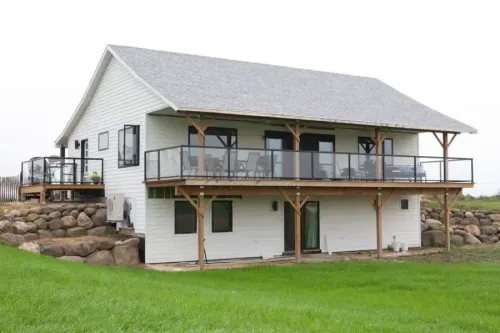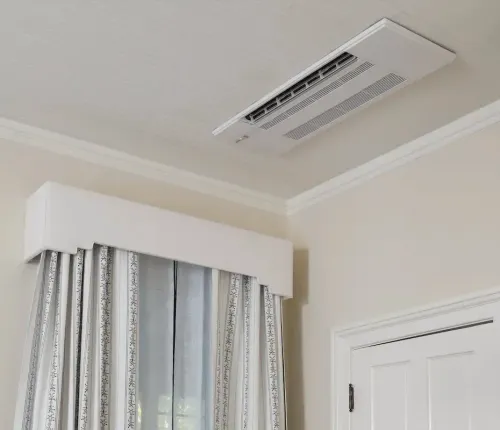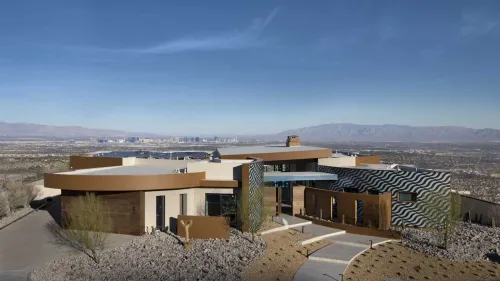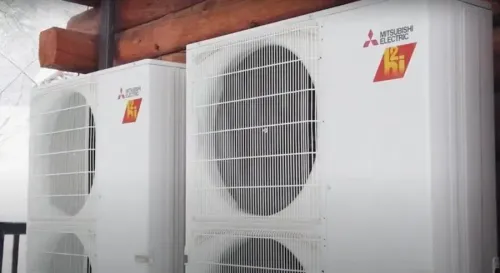Project Location: Southampton, New York
Completion Date: July 2015
Challenge
Finding an HVAC system that would stand up to LEED’s tough energy efficiency standards and to Mother Nature’s toughest stormsSolution
An H2i® system from Mitsubishi ElectricResult
Impressive energy efficiency and peace of mind
Hurricane Sandy made landfall in October 2012, damaging or destroying hundreds of thousands. of homes. One of those homes was a 1940s cottage that belonged to Kim Erle, LEED® Ap, founder and president, Sunset Green Home, Llc, New York. When it came time to rebuild, Erle didn’t just set out to build a new home, she set out to build the coastal home of the future—a highly efficient, resilient house that would stand up to future storms and serve as a model for responsible building practices. In practical terms, that meant high-performance subfloors to weather-resistant aluminum roofing and a multi-zone Hyper-Heating INVERTER® (H2i®) system from Mitsubishi Electric. The result: a place to call home for years to come. The goal now: to have LEED certification in hand
The idea of LEED certification took root when Erle discovered “green building tax incentives in our municipality. The incentives work out to about $15,000 for LEED homes. So if we could do certification for $15,000 or less, it made sense. We were going to build something green anyway; this was the extra step.”
From an HVAC perspective, taking that extra step was all about finding the right system. Erle explained that earning LEED certification means “you have to follow Usgbc requirements for the sizing of the system and the design of the ductwork.”
Erle spoke with an HVAC contractor who recommended meeting those requirements with “two, 3-ton solutions for a total of six tons. But we couldn’t exceed four tons. It really surprised me that the contractor was not taking an integrated approach. Contractors are used to customers complaining about leaky houses, so they put in a big system. With new, energy-efficient houses, though, you have a good envelope and air-tight windows. You don’t need such a big HVAC system.”
Erle kept looking for a solution using a traditional system “but we ran into two problems. One, high-efficiency systems are hard to find in a small size. Two, we were having trouble fitting ductwork into the home’s original design. Then Rich Manning, our energy specialist, said to me, ‘You know, Kim, you really ought to do mini-splits. Take a look at ducted. You can put air into every room. You can have individualized comfort, and there won’t be a duct issue because the mini-splits would have short ductwork from the attic.’”
Manning, owner, Energy Master Li Building Consultants, Hauppauge, New York, offered insights like these based on his 10 years of HVAC solutions design experience. He also served as the project’s green rater for Usgbc and Home Energy Rating System (HERS) certifications. Manning was a big proponent of mini-splits: “Most of the ductwork I inspect leaks and doesn’t pass the duct leakage test required by Energy Star. Duct leakage accounts for up to 40 percent of heat loss to the outside. With mini-splits you almost eliminate that possibility of leakage. You also get variable speed, so you’re only going to use the energy you actually use. Between that and having no ductwork on the outside, you get a lot of efficiency, which brings the HERS number down.”
Erle was sold on the idea and believed Mitsubishi Electric was the right company for the job. “They are very well-respected. The representatives have also been so welcoming, responsive and knowledgeable.” The new HVAC contractor, Flanders Heating & Air Conditioning, Riverhead, New York, is a Diamond Contractor® for Mitsubishi Electric. Owner Doug Matz said, “Mitsubishi Electric has been in the U.S. for decades and we’ve been working with them for 30 years. They’re a strong provider of a high-quality unit. They have a reputation of being the best, and their service support and engineering support are second to none.”
Flanders’ residential systems designer, Rick Blydenburgh, added, “The house is going to be so energy-efficient that it was important for the HVAC system to get substantial efficiencies. Mitsubishi Electric’s hyper-heating pump with INVERTER technology gives better efficiencies while more effectively producing heat down to lower temperatures. It’s also much quieter. Conventional systems come in at about 60 dB(A); hyper-heating comes in at about 40.”
Construction finished last month. For the HVAC system, that involved mounting three indoor units in the attic and two in the drop ceiling of the first floor. “The outdoor unit is behind the outdoor shower by the edge of the pool deck. It fits there perfectly and it’s great that we have just one compressor,” said Erle.
As Erle begins to enjoy her new home, she’s also anticipating impressive energy efficiency. “Our expectation is, first of all, that the system will provide all of the cooling and heating capacity the project requires. The rated efficiency of the system is higher than in traditional systems. And since the duct runs were short and optimally installed, we’re not expecting leakage.”
What Erle is expecting is that the five zones throughout her home will offer a range of usage profiles. “That’s why we really like the idea of multi-zone. It allows us to capture more efficiency despite the house’s occupancy varying greatly. My children are adults. If they’re home with guests during the summer, we could have 14 people sleeping in the house and wanting air conditioning because it’s 90 degrees outside. If it’s a winter weekend, it could be just me and my husband; we don’t want to heat rooms if they’re unoccupied.”
Erle thinks a lot about the big picture: the effect that the environment has on her home and the effect that her home has on the environment. “All of our thinking on the design of the HVAC system—the whole house, really—was to take a system approach, a holistic perspective, to design it to be as effective as possible.” The hope is that whatever happens with the weather and however many visitors come by on a balmy summer weekend, Erle’s home will not just stand up to the test, but do so efficiently and sustainably. Luckily, she has the right equipment to do the job.
Project Team
- Homeowner and Sustainability Consultant: Kim Erle, founder and president, Sunset Green Home, Llc, New York
- Green Rater: Energy Master Li Building Consultants, Hauppauge, New York
- HVAC Contractor: Flanders Heating & Air Conditioning, Riverhead, New York
Mitsubishi Electric Equipment Installed
- (1) MXZ M-Series Outdoor Unit
- (5) SEZ Horizontal-ducted Indoor Units









